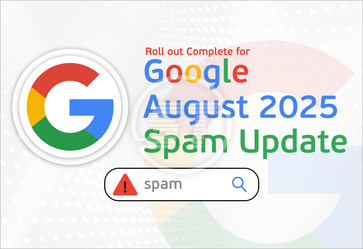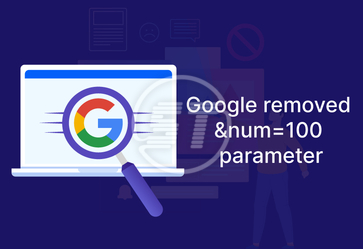Suppose you’re scrolling through a series of blog articles and once you reach the end of the page, you may encounter a text that says “read more”. Once you click through it, you may be directed to a longer list of blog posts. However, if you were a visually impaired person and relying on a screen reader, once you reach the end of the page, you’d be stuck in the endless ‘read more’ loop without further navigation. Instead of such a vague text, had the developer added a “read more blogs” snippet that is more descriptive, your screen reader would perform seamless navigation. However, minor it may seem to you, but for a visually impaired person, it does make all the difference by providing access to meaningful content on your website.
If your visitors find issues with your website such as intricate navigation, poor layouts, concealed call-to-action (CTA), bad web forms, hard-to-read content, etc. chances are high that your visitors abandon your site without coming back ever. This would have a direct impact on your SEO score resulting in a slump in search rankings. Thus, web accessibility offers a path-breaking benefit in the form of higher search rankings that go beyond optimized user experience. Hence, you need to empathize with your target audience and build your site so that it is not just optimized but also accessible to everyone. Website accessibility should thus be one of the important elements of your SEO strategy.
A fine line between Accessibility and SEO
We need to understand that web accessibility practices greatly translate into amazing SEO strategies, however, the vice-versa is not true. That is, not all SEO tactics improve web accessibility. For instance, keyword stuffing in the alt attribute of your image tag works well in terms of SEO, but for a screen reader, this may seem to be nothing but gibberish nullifying your web accessibility strategy. So, the thin line between accessibility aspects and SEO strategy should be carefully curated to pan out the results the way you desired.
Quality Keywords
Keyword stuffing is a common culprit in the proper keyword strategy. It can kill your SEO! Search engines often look for some cues to understand what’s your website is all about. For example, as we talked earlier about stuffing the alt attribute in the image tag, it is not going to improve your search engine rankings in any way. On the contrary, a slump in the search rankings shouldn’t be a surprise. Added to the keyword overloading are the hassles that a screen reader has to face. A quality text providing a proper context to both the screen readers as well as search engines is what is needed. The basic tenets of SEO correspond to accessible web content which should form the foundation stone of your SEO strategy.

Better User Experience
User experience is the ultimate factor that matters the most in SEO. Various factors impact the user experience on your website. A frictionless experience with a simple and easily navigable website structure is a huge bonus to you. The site speed also makes or breaks your user experience. With mobile traffic on the rise, having a great mobile experience is also an added bonus. Proper color contrasts, keyword navigation, descriptive headings, clear language, logical and structured layouts naturally lead to a better user experience even for people with disabilities. And that’s what matters the most for search engines boosting your SEO.
Wider Audience Reach
More than 25% of people in the US are disabled. Hence, making web accessibility an afterthought is actually an ineffectual plan. Web accessibility widens your audience reach by improving your ability to reach more people. Firstly, you are not denying access to people with various disabilities - visual, auditory, neurological, physical, motor, or cognitive ones. Everyone would be able to easily access your website without any hindrances. When your website is accessible, they also get better rankings in the search engines. This is positive reinforcement and it happens in a circular loop. When your website is accessible to a larger audience, it is easy for the search engines too to find your website more relevant, having a knock-on effect on search rankings.

Mobile Accessibility
Mobile traffic has totally eclipsed desktop users today. A huge chunk of traffic has been coming from mobile phones. As more and more content is consumed on handheld devices, mobile accessibility has become a crucial pillar of SEO. Poor mobile accessibility inadvertently hurts your SEO. So make your content flexible and resizable by following WCAG guidelines which reduce the need for third-party assistive technologies. Proper color contrast and font sizes impact the mobile user experience and they are likely to convert. Thus, improved SEO is a positive ramification of mobile accessibility.
Ease of Navigation
With web accessibility measures, one can ensure easier and consistent navigation even across a robust website. Navigation issues shouldn’t be ignored as a person with a disability may feel discriminated against and excluded from web access. Websites should be able to be accessed by keyboard, mouse, or any device for easier access and consumption of website content. There should be a plethora of digital landmarks in the code so that those users who rely on screen readers and other assistive technologies can navigate properly without facing any roadblocks.
Web accessibility entails providing text for non-text content, ensuring that your written content is in a readable format, logical formatting of your webpage content, using headings intentionally, and complying with WCAG standards. These inevitably ease the navigation of the users as they don’t have to rely on the text on the web page all the time.
Conclusion
Don’t get overwhelmed if you’ve never incorporated web accessibility into your SEO strategy. It’s never too late! Plan and prioritize web accessibility. Remember, web accessibility and SEO are overlapping strategies both having a similar scope of improving your user experience and taking you to a wider audience. On the outset, it may seem to be more expensive and daunting requiring web design overhaul, tweaking the layout changes, and rewriting the SEO strategy. However, all it takes is a prudent plan to make minor tweaks, and follow best practices to make your websites more accessible and SEO-friendlier.
When You choose the accessibility option for your website, it becomes universally accessible & it creates a positive user experience that is not only good for your business brand but also SEO. We can make your website ADA Compliant. Our specialized team of website designer ensures a Search engine friendly and user-friendly experience based on browsing patterns of the target audience and business need. Get a Free ADA Compliance Audit!


